
Fashion, water use cut bird population
FLORIDA CITY, Fla.— “We observed great flocks of wading birds flying overhead toward their evening roosts … they appeared in such numbers to actually block out the light from the sun for some time,” said naturalist and artist John James Audubon, whose love was the birds of North America.
Audubon made this remark on a visit to South Florida around 1832. Today however, this would not be the case. Only 10 percent of the size of the population of birds that existed when Audubon visited exists in 2006.
“For every bird you see here, you would have seen 10 more 120 years ago,” Park Ranger Leon Howell said here at the Ernest F. Coe Visitor Center.
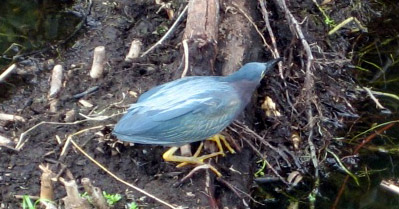 |
An immature baby green heron out in the open at Royal Palm in Everglades National Park (Photo by Kim Stabler). |
“This 90 percent decrease is due to just two main causes— women’s fashion and the human alteration of the water cycle,” Howell said.
In the 1880s, the value of plumes for women’s hats exceeded that of the value of gold. Two of the main types of birds of the Everglades, herons and egrets, were almost killed off for their plumes, leaving their young to die as well. Laws ended the hunting for plumes, but another problem arose.
Between the 1940s and 1960s, humans began to drain the Everglades for urban and agricultural reasons, and they built roads that restricted water flow. With the decrease in water came a decrease in food, shelter and space for animals.
After this happened, too much water was added to compensate, which flooded some small pools of fish and made it harder for birds to find food. Birds use the water cycle to perfectly time their nesting in order to raise their chicks. Naturally, both of these caused declines in the number of birds.
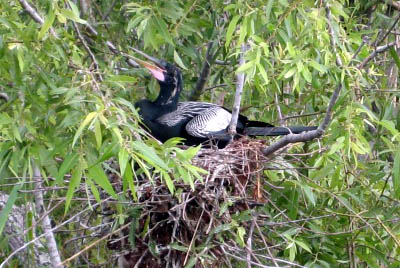 |
A mature anhinga nesting in a tree at Royal Palm in the Everglades (Photo by Kim Stabler). |
Currently, there are 350 species of birds residing in Everglades National Park. Of these, 16 species are wading birds. Wading birds are also the most popular and most easily visible birds in the park. These birds are known for their long legs, which they use for wading in the water to search for food.
Examples of wading birds in the Everglades are the white ibis, the wood stork, the green-beaked heron and the great white heron.
The most endangered wading birds are the snail kite, the short-tailed hawk, the Cape Sable seaside sparrow and the wood stork. These birds are the most endangered because they are the most easily disturbed. The wood stork is known as the “barometer bird” because it will judge the future of the Everglades.
As Howell said, there is an old saying: “As goes the wood stork, so goes the Everglades.”
There are also land birds in the Everglades, 60 percent of which are migratory; the other 40 percent are true natives to South Florida. Every winter, up to 5,000 birds migrate to the Everglades. Some of these land birds are cardinals, blue jays and red-bellied woodpeckers.
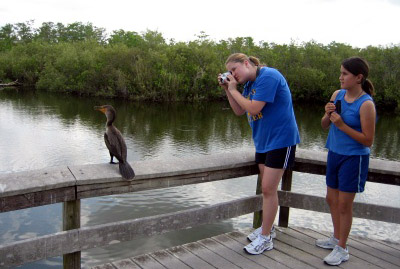 |
Visitors get a close-up view of an Everglades resident (Photo by Kim Stabler). |
For great bird watching in Everglades National Park, make sure you go in the winter.
“In January and February, it will be scary how many birds you will see and how close you can get,” said Howell.
The Anhinga Trail is located a short distance from the Visitor Center west of Florida City. The trail is named after the prevalent bird, the anhinga.
“It is one of the most popular trails and is one of the best wildlife viewing areas in the park,” said Howell. The trail follows a man-made canal along the edge of Taylor Slough (a river-like area in the marsh).
At Anhinga Trail, visitors can take a guided walk along a boardwalk with a park ranger or walk it alone. Visitors can take 50-minute walking tours called the “Anhinga Amble” every day of the week at 10:30 a.m. and 3:30 p.m. Persons interested in the tour should meet at the Royal Palm benches.
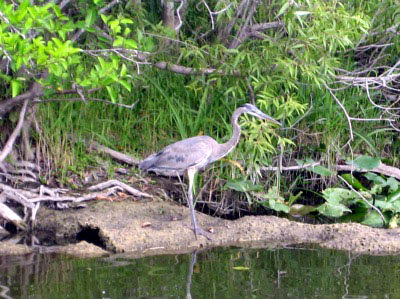 Howell was a good guide for those who decided to walk with him on a late spring day. His knowledge of the Everglades and 21 years of experience at this job have made him very knowledgeable. And he loves what he does.
Howell was a good guide for those who decided to walk with him on a late spring day. His knowledge of the Everglades and 21 years of experience at this job have made him very knowledgeable. And he loves what he does.
He began the tour by telling visitors about the history of Everglades National Park and how it came to be. It began due to the waters flowing out of Lake Okeechobee.
He taught the 30 or so visitors about the ecosystem, the wildlife and the park’s current problems.
Along this trail we saw many birds, including the most common, the anhinga and cormorant. Alligators, turtles, fish and other wildlife were in abundance as well.
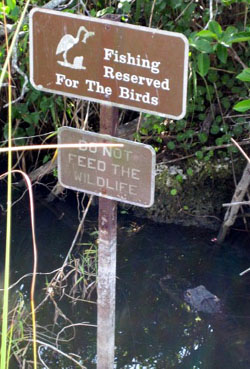 The anhinga is a tropical bird with a pointed bill used to stab fish. It is also called the “snake bird” due to the way it swims underwater. Because its wings get very wet when it swims, it is known to sit on tree branches and spread its wings with its back to the sun. This is not just to dry off, however. It is mainly used for thermoregulation, or to warm up.
The anhinga is a tropical bird with a pointed bill used to stab fish. It is also called the “snake bird” due to the way it swims underwater. Because its wings get very wet when it swims, it is known to sit on tree branches and spread its wings with its back to the sun. This is not just to dry off, however. It is mainly used for thermoregulation, or to warm up.
The cormorant is very similar to the anhinga, however, it has a hooked bill and its feathers do not allow it to get very wet due to its high buoyancy. The two birds look and behave alike, but are different.
Can we make the changes needed to save the magnificent birds of the Everglades and continue to increase their population; or will we witness the disappearance of the last few flocks?
It is up to everyone today to care about the restoration of one of the nation’s most well known parks. With the $10 billion Comprehensive Everglades Restoration Program passed by Congress in 2002, there is room for optimism. It is the largest environmental project to date.
“If the will of the people stays behind the efforts, it will get better,” Howell said.
Why should one care about this national park?
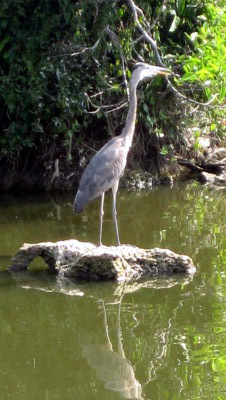 To answer the question of “Why are we here?” Howell had three reasons at the end of the tour.
To answer the question of “Why are we here?” Howell had three reasons at the end of the tour.
First, he mentioned that everyone has a personal value with nature.
“It just feels right to be here,” he said.
Second, “experience is all from the same reservoir,” he said. “You lose a color of the rainbow if you lose one ecosystem.”
And last, relating to birds, if we lose the Everglades as an ecosystem it means fewer birds where we live because of their migration patterns.
So the next time you plan a trip to Everglades National Park, don’t forget about the birds…and remember to save the fishing for them.
If You Go:
- Ernest F. Coe Visitor Center, Florida City, Fla.
- Open daily, all year, 305-242-7700
- Hours: Dec. 18 to April 16, 2006, 8 a.m. to 5 p.m.; April 17 to Dec. 17, 2006, 9 a.m. to 5 p.m.
- Directions to the main park entrance and Flamingo: Visitors coming from the Miami area and points north may take the Florida Turnpike (Route 821) south until it ends, merging with U.S. 1 at Florida City.
- Turn right at the first traffic light onto Palm Drive (State Road 9336 / SW 344th Street) and follow the signs to the park. Visitors driving north from the Florida Keys should turn left on Palm Drive in Florida City and follow the signs to the park.

Comments are Closed